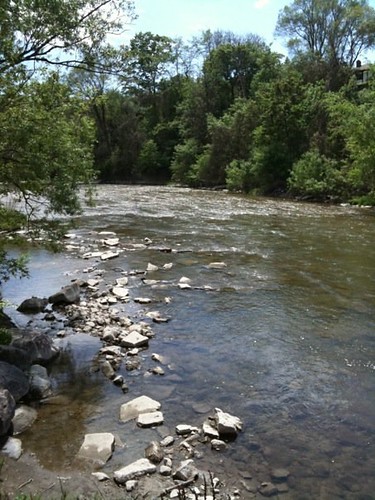 |
| The Humber, as seen between Cruikshank and Lions Park, near the intersection of Lawrence Ave. W and Weston Road, Etobicoke |
[This is an intro to a series of walks that I will be posting in relation to the Humber River. While I have have walked the whole of the river from the City boundaries to the Lake, I have yet to attempt an full, unbroken trek from the top of the city to the bottom, but have plans to do so in 2011. ]
Toronto has the unique distinction of having Canada’s only designated urban Canadian Heritage River flowing through it’s bounds, the Humber River. This beautiful river gently dissects the city from top to bottom with a graceful, peaceful ribbon of green. The river is one of two that divides the city, creating natural geographical boundaries that physically separate the city into distinct regions. The other is The Don River Valley on the East side of the City. I have yet to make my way to the Don yet, but I’m slowly moving eastward in my treks and hopefully I can start some trekking there this summer.
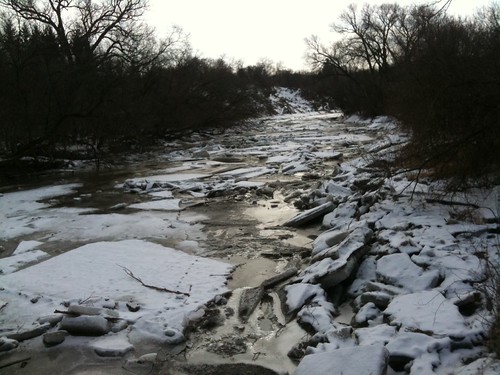 |
| Temporarily Tamed by Winter's Touch |
What makes the Humber so culturally important and why should you care? First and foremost it is beautiful. It wends and twists and gently curves it’s way to Lake Ontario. Old trees grace it’s shores. A multitude of birds and animals, including deer, can be spied near it’s banks, bringing the wilderness straight the city. It has carved deep ravines through the city creating an oasis of peace and silence. You can be conscious that the city’s hustle and bustle might lay just beyond the crest of that hill but be so far removed from it that all cares and worries are forgotten. At first glance, it seems slow and calm, but watch the water flow over many of the engineered spillways along its route and witness its mighty power. At its end, it swells and slows and supports a serene marsh.
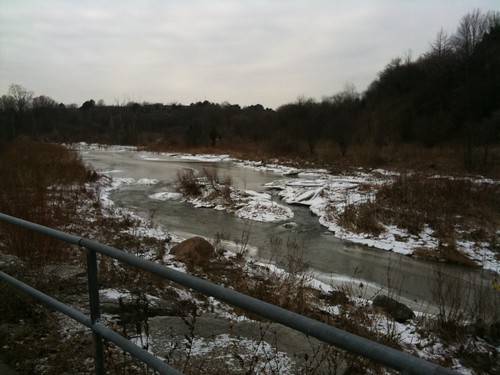 |
| Summerlea Park, Winter 2011 |
It was first used as a trading and portage route for our First Nations peoples and the “Toronto Carrying Place Trail” follows it’s banks. Earliest evidence of human settlement along this river points back in time to a possible 10,000 years of human impact on the river.
 |
| Late Fall 2010, Pine Point Park |
There is debate as to whether Étienne Brûlé, on behalf of Samuel de Champlain, became the first European to explore and live along the banks of the river, establishing trade and diplomatic relations with the First Peoples here. One park along the banks of the river is named after him, however many scholars now believe he may have actually located much further west.
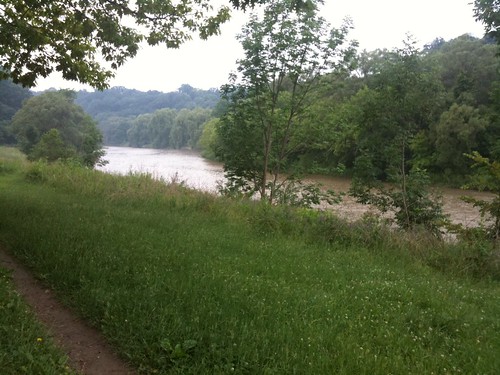 |
| Summer 2010, Magwood Park, Etobicoke |
The Humber was vital to the early development of the city. Fort Toronto was founded at it’s foot where it met Lake Ontario and was a temporary home of the first Lieutenant Governor Simcoe when he first arrived in the area. Settlement continued to grow outwards from the Fort. Over time the fast flowing waters powered numerous lumber and grist mills along its banks, providing the materials to build the city and strengthen its economy.
 |
Kipling Heights Park [not 100% sure on that one - may have been further up river], Winter 2011, Etobicoke |
On the night of October 15, 1954, Hurricane Hazel struck the City with great force. It is rare for a Hurricane to make its way this far in land, usually they dissipate in strength once they hit landfall, and indeed, while this storm had been downgraded to a tropical storm, it proved to be a powerful one. Already, it had caused horrendous devastation in Haiti. It tore through the Carolinas and, instead of losing power, then steamrolled its way northwest to Toronto. Despite, what was for the time, very accurate weather forecasts, few people paid heed to the warnings. Storms of this strength had never been experienced here and the naïveté of Torontonians created a lax atmosphere that was unprepared for what was to come. The storm raged late into the evening. The water table was already saturated from heavy rains experienced the week prior. Streams, rivers and creeks were at their peak. The stage was set for a disaster.
 |
Memorial to Victims of Hurricane Hazel, Raymore Park, Etobicoke. This memorial incorporates the remains of a bridge swept away by flood waters. |
The rains of the evening proved too much and large flash floods raged through the City along the Humber River, Don River and Etobicoke Creek, taking residents by surprise. Many houses were ripped from their foundations, bobbing their way along the rushing waters towards the lake; some residents spending a cold terrifying night on their roofs, waiting for rescue that could not come. Efforts to aid victims were hampered by the strength of the currents and an inability to find boats of sufficient horsepower to navigate the waters. Many of the rescuers quickly became stranded themselves or lost their lives to the raging currents. Thousands were instantly rendered homeless. Eight-one lives were lost that evening. Bridges were washed out throughout the city, creating traffic snarls for months after. Several highways and rail lines were washed away, including the 401, creating headaches to find alternate means to move goods across the country. To this day, with an estimated cost of at least $1 billion of today’s currency, it remains the largest natural disaster ever recorded in Canada.
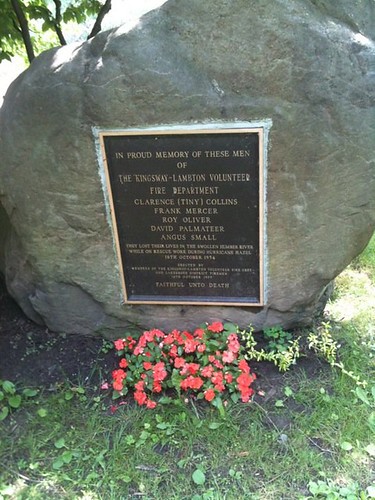 |
| Memorial to firefighters lost in the chaos of October 15, 1954. Their firetruck was swept away as they attempted a rescue. Home Smith Park, Etobicoke |
The Canadian military was called in to deal with relief efforts and clean up. Relief agencies immediately went into action, raising millions of dollars of funds from all over the world. Provincial and federal governments expropriated much of the property along these rivers and placed strong restrictions on further development. National flood plain management and strategies were implemented nationwide to prevent similar disasters elsewhere. The Toronto and Region Conservation Authority was created to help manage these areas. These areas are now planned as flood zones, where water can be allowed to move freely through the City without major impact on nearby residents. Spillways, dams, retention walls and other engineered features along the river help to restrain and minimize flooding and direct the water when needed. Yet even with all that management, the River is one to be respected. Flash floods still do occur especially during the Spring thaws or after heavy rains. Its current is strong. Along it’s banks lie memorials to victims, many children who have been caught within its grip.
 |
I shamefully wish I could tell you exactly where this picture was taken, but I seriously need to work on my note-taking skills... Winter, 2011 |
But out of that horrible devastation, Torontonians were given a special and unique gift. Deep into the heart of the City, fingers of forestry and nature tangle their way seductively towards the Lake. Deep forested ravines isolate portions of the rivers from the City creating sanctuaries of greenery and silence. Long stretches of recreational zones have been created along its banks and are easily accessible to most within the City and provide opportunities for biking, hiking, jogging, rollerblading dog walking, boating and fishing. Need a first date idea but not a lot of cash? A stroll along the Humber’s many parks provides an idillic spot to picnic and walk hand in hand. Bird enthusiast? The Humber provides plenty of opportunity to spy your avian friends. Avid cyclist looking for an opportunity to bike a long distance without City traffic? The numerous bicycle paths along its banks negotiate steep hills and turns and it’s long distance is a good opportunity to work on your endurance. Don’t have a car but want to experience nature? This is close enough and is easily accessible all along it’s bank via the TTC. A portion of the trail system is even accessible by subway via Old Mill station.
 |
| Magwood Park, Summer 2010 |
In the following weeks, I will continue on with more in depth segments of the parks to be found along it’s path, in chunks that will allow for 2-3 hour hikes. Several Discovery Walks also line it’s shores and I will focus on them as well. Hopefully, I can aspire you to get out and take a hike, and if you’ve never been here before, experience a portion of the City that is like no other.
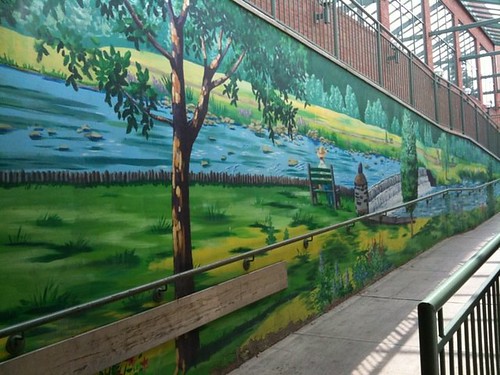 |
A mural tribute to the Humber found at Loblaws near Dundas St. W. and Scarlett St., Etobicoke |
Happy Trails!
Some links of interest:
Some links of interest:
No comments:
Post a Comment